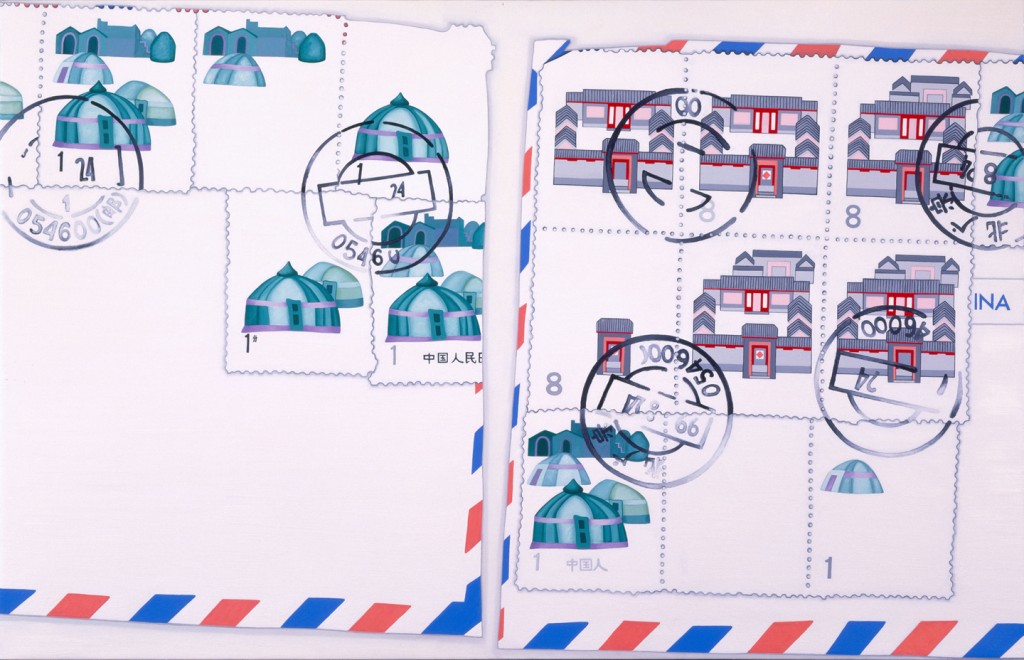Li-lan’s recent paintings do not present faithful renderings of stamps, envelopes, postcards, cancellations, and registered mail stickers (among other postal stickers and marks); the works do, though, present a language constructed from skillfully painted and freely manipulated images of these artifacts of the mailing process. Through this language Li-lan rewards the attentive viewer’s contemplation with everything from jokes to discussions of the formal aspects of painting to the positing of broader cultural and sociological issues.
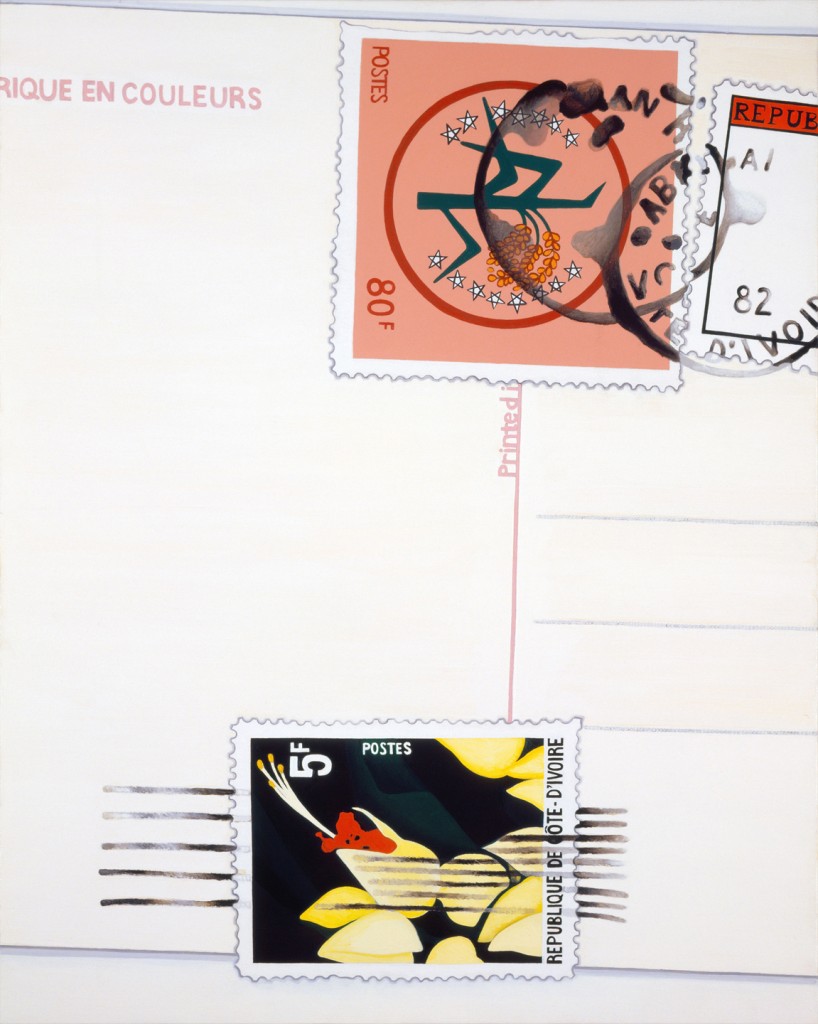
Afrique en Couleurs, 1992
Afrique en Couleurs, is one of the paintings in the show entitled Post Marks that will be on view at Art Projects International in New York, from October 27 to December 1, 1994. Depicted is a two and a half foot high close-up of the middle section of a postcard. In this section, three colorful cancelled stamps of the Ivory Coast are visible. Also visible is the postcard manufacturer’s printing which includes lines on which to write an address, none is there, and the cropped phrase at the upper left of the painting RIQUE EN COULEURS. Here the viewer is presented with an ironic chuckler. The printed cropped words, from which the title is taken, apparently refer to whatever image would be on the front of this card. But instead of some colorful image of Africa, the viewer is confronted with a colorful combination of three African stamps. This joke is weightless until the viewer takes into consideration that the juxtaposition of the printing and the stamps is not just a happenstance find of the artist’s to be shared with the viewer but is one element of a carefully crafted fiction. Whether or not a model for the painting exists, the outsized postcard depicted in the painting does not. It is a strength of Li-lan’s work and a worthwhile one for the viewer to keep in mind that each aspect of each painting, be it something as obvious as the painting’s dimensions or something as inconspicuous as a smeared cancellation, is carefully considered and either artificially recreated or invented.
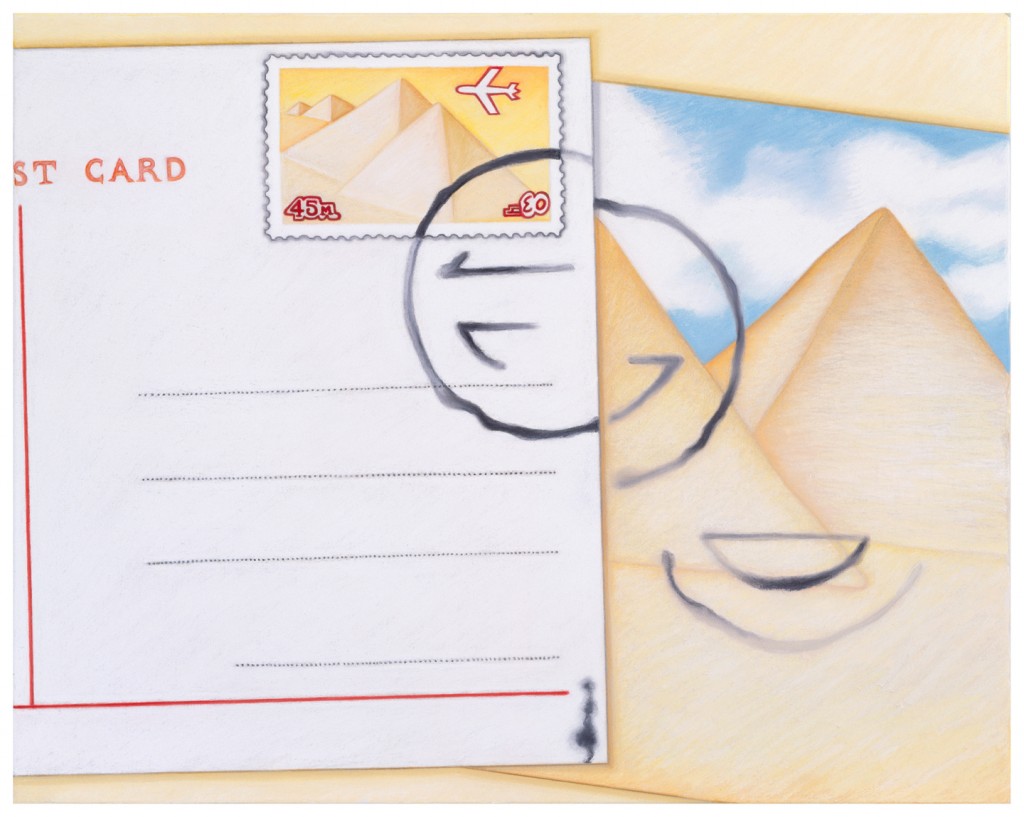 Post Card: The Other Side, 1993
Post Card: The Other Side, 1993
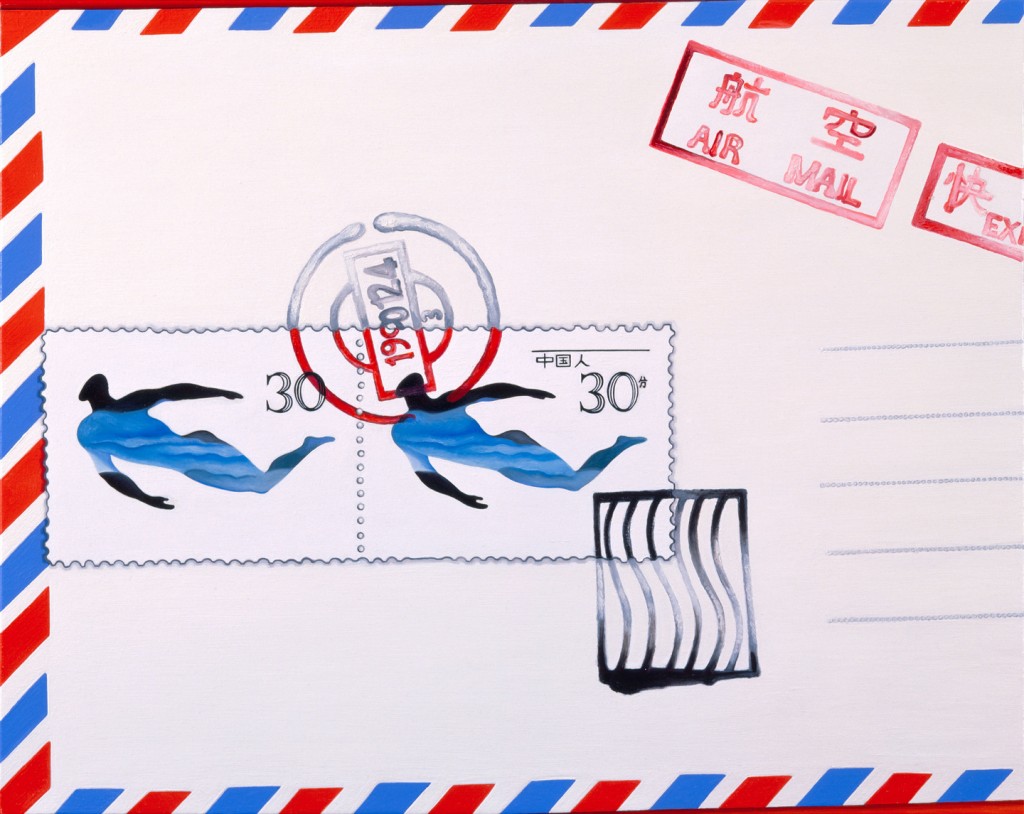
China: 30 Yuan – 1993
With Afrique en Couleurs, then, what could have been a closed joke with the other side of a postcard as the punchline becomes an open-ended question in light of the nonexistence of the painted image’s other side. Functioning in a like fashion, subtle sight gags appear in a number of guises in other paintings: Post Card: The Other Side presents the impossible situation of a face-down postcard resting atop its face-up self; in [China:] 30 Yuan, swimmers who appear on two oddly placed stamps seem to be swimming off an envelope and out of the painting; From China depicts two envelopes covered with combinations of two different types of stamps of buildings and through these combinations and Li-lan’s inconsistent renderings of the details of like stamps and, finally, through the placement of the two envelopes the final overall effect is of buildings resting in a landscape; in Headdresses an out of control cancellation which runs across a band like pattern on an envelope suggests the feathers in the headbands of the Indian headdresses which appear on the envelope’s cancelled stamps.
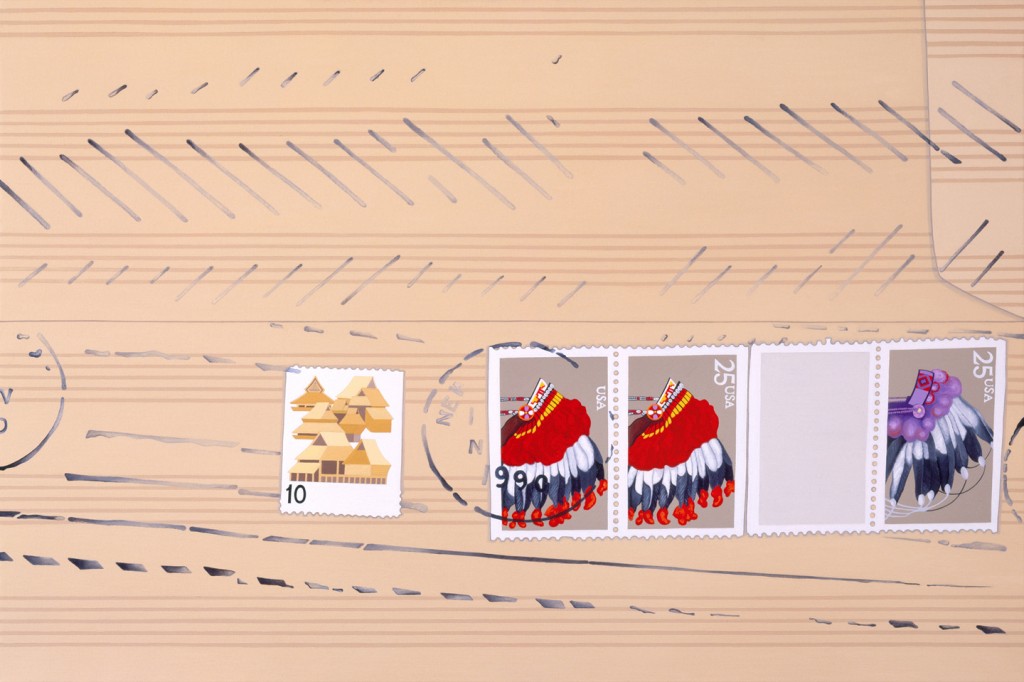
Headdresses – 1993
These gags, far from being the primary focus of Li-lan’s work, serve as the viewer’s entry into works rife with multiple concerns. Underlying surface usually only appears as a thin angled strip at one or more of the edges of the paintings. This obvious contrivance not only allows an edge of a letter or postcard to be set at an angle to the edge of the painting but also pointedly brings to the fore considerations of depth of field, surface, and composition. The depth of field in these works is clearly defined; it is the quarter inch or so from the hard surface to the visible surface into her language Li-lan at once defines the object depicted as tangible and then through scale, cropping, and technique takes this back and exposes the painting as just marks on the surface of a canvas. The confusion between surface and image is exasperated by the unmodulated painting of the blank spaces of the postcards and envelopes which allows these spaces to be either read as depictions of paper or as actual canvas. The visible strips of underlying surface can also be read as compositional elements, and starting from these strips the viewer can question the nature of the entire composition. The viewer then must acknowledge that everything from the natural looking placement of stamps to the width of an airmail envelopes striped border has been manipulated to create the final integrated composition.
 Security: Front and Back (diptych) – 1992
Security: Front and Back (diptych) – 1992
Li-lan’s refined postal language allows her to broach issues broader than her means of consistant subject matter would suggest. Security: Front and Back, is a large diptych (32″ x 104″) which depicts the front, on one panel, and back, on the other panel, of a registered letter. The envelope has a broad and bold red and blue airmail stripe border, and is covered with large postage stamps and registered mail sticker. The effects of these substantial markings, stamps and stickers is to create a sense of security – a sense that whatever could be inside the envelope is well protected. The presence of the French word for registered, when referring to mail, securite on the registered mail stickers, lets the viewer know that the work’s title is ambiguous; the word security of the title could refer to a state of security or could be nominal. The viewer might wonder what could be in the envelope that needs to be secure, or what are the signs of security and why does this envelope look secure, or the viewer might notice the envelopes slightly bent and folded corners and wonder, despite the presence of signs of security, how secure anything is.
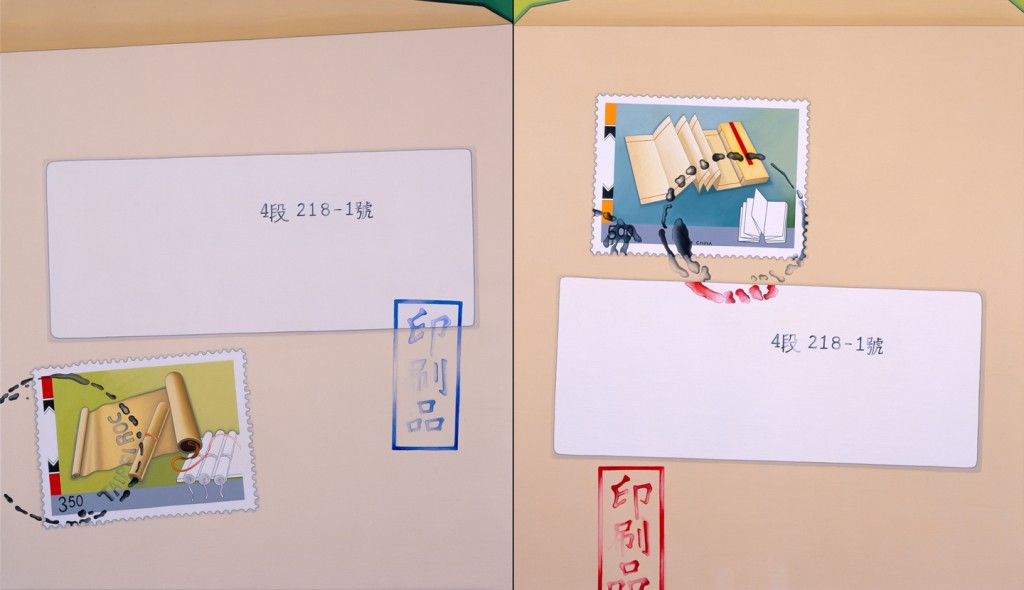 Correspondence: Between Two (diptych) – 1994
Correspondence: Between Two (diptych) – 1994
Another work that raises questions beyond its obvious scope is Correspondence: Between Two. Depicted in this work are two envelopes side by side. Each envelope has of its surface a canceled stamp and, unusually for Li-lan’s oeuvre, an address. The address on each envelope is an identical combination of numbers and Chinese characters. The stamps are different but both have writing paper as their subject. What at first appears as a straightforward and pleasing arrangement of envelopes, stamps, labels, markings, and background surface becomes an enigmatic puzzle. Again, the topics that arise are multifarious and include the nature of correspondence between two people, the nature of correspondence with one’s own self, and the nature of correspondence between the artist and the viewer.
Li-lan’s paintings are of that rare sort that are meticulously crafted, aesthetically pleasing, and topically relevant. Their sensible arrangements, colors, and subject matter will engage the casual observer, but these painting’s true worth lies in the integrity of their underlying language and the wealth of musings they and this language offer up to the contemplative viewer.

Erik Bakke is the Editor of aftershockmagazine.com andan artist (erikbakke.com). He lives in San Francisco.
